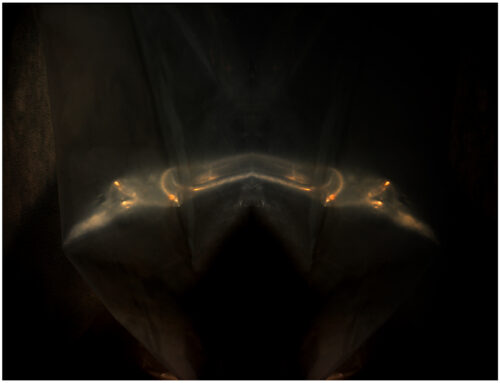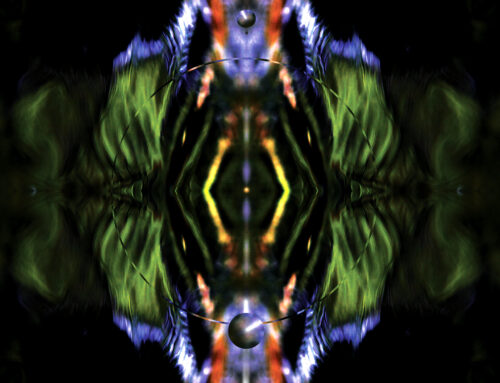CONVERSATIONS WITH KADOS

The World The Day I Died, galengraph 2018
Entry Seven: Dialogue with my alter ego, Kados
“What are you doing, Galen?”
“I’m writing—typing, to be exact—about what I hope to be doing. Soon.”
“Yes, I see that, but why? Why write about something you’re doing. Just do it.”
“You don’t understand, Kados. It’s an alignment process.”
“A what?”
“Never mind. You might remember that at some point, after finishing my autobiography, in late 2017, almost three years after I began, while on the book tour, I decided I’d get back to the painting. I promised Lennie I would. When I built my house, here in the countryside of Northern Thailand, the open-air downstairs became my studio. It seemed perfect, but I soon realized that the first floor wasn’t high enough. Didn’t work. I quickly built a high-roof shed on the side and began working on ‘Notations,’ you know, that series of paintings that…”
“Most of which you destroyed.”
“Yeah, I know.”
“But why? Why make something and then destroy it?”
“True. But the real problem, Kados, turned out to be the elements of the outside world—mildew, snails, frogs, lizards, wasps, ants, and mosquitos. They seemed to be my most excited patrons, so much so, they immediately began taking up residence inside the stretchers, on the painted surface itself, basking in the color fields, building mud huts in the textured weave of the canvas, or leaving gloomy deposits of greyish white everywhere. Impossible.
“You do recall, Galen, why you left the United States. Remember the elephants?”
“Sure, of course.”
‘And do you recall what you told us when you left the commercial art world, and your Seattle gallery.”
“uh-huh.”
“And you must certainly remember the little epigraphic poem you wrote not that long ago.”
“You mean the one about ‘When I was young.’”
“Yeah, recite it.”
“I can’t remember it.”
“Yes, you can. Say it with me. ‘When I was young, I wanted to paint big. And I did. The older I get, the smaller I want to paint; today, a portrait the size of a postage stamp, tomorrow, a dream on the wing of a fly.’”
“So, what are you telling me, Kados? I can’t change my mind.”
“Galen, you’re talking to your mind.”
“Oh yeah, right.”
“So why now? Why go back to these big canvases that are so damned enticing for insects and so incredibly difficult to get to market? Why paint at all? You’re old. Why don’t do you just shuffle off to the garden and ruminate on ‘what ifs’, ‘whys’, and ‘whens.’
“You’re funny, Kados. In fact, I do. All the time. Have for years. Trying to figure out why I’ve made what I have, why more, and why me? Why is any of it important? Does it make a difference? Can it?”
“And?”
“And what?”
“Galen, have you figured anything out?”
“No. Truthfully, friend, there’s no answer to such questions. I can only say that when the gods set us down for this short stay they gave us something to bind us one to another, to remember those who came before and possibly to help those who follow. I want to believe so. We’ve shaped poems, told stories, painted paintings, and made music for as long as—no, longer than—the gods have shadowed us. Art is this ineffable ocean of human expression made for and in spite of ourselves; it is a fingerprint of our history. Do you not believe, Kados, that anything so long lasting has a reason and a purpose for its durability?
“I don’t know, Galen, but I feel like I’m drifting into a poor mans’ Socratic dialogue. Talk about here, and now, and why.”
“OK. The new studio space, which has been my main living space, upstairs and fully enclosed, protected from the elements, is nearly done. I’ve designed it to hold anywhere from eight to ten paintings-in-progress, that can be then rolled and stored for shipping. My plan is to create a series of large paintings, perhaps 15 to 20 in all, of various sizes, but on average, roughly about 6’ x 7,’ some larger, some smaller, over the course of the next 12 to 18 months. I plan on returning, in part, to visual explorations I made back in the late 1970s, juxtaposing shapes that dance, shift, and realign across the picture plane creating a rhythm, if you will, of visual tensions and resolutions.

Untitle Collage, 7′ x 13′ commissioned by Don Foster, 1978, photograph Architectural Digest 1979
In those days, of course, these were enormous collage works in which I created the painted papers on the floor of my studio, using my hands and arms to transfer a kind of energy directly into simulated textures. I want now to achieve similar dynamics, but using a more intensified palette with the medium of oil on canvas.

the artist, Galen Garwood, at work, Seattle, 1978
“That’s all well and good, but will they survive?
“What do you mean?”
“Will you destroy them before they get out of the studio?”
“This is different. This is the realignment. Besides, these paintings are not only dedicated to coming into actuality and remaining, but, as well, a few patrons are investing in the series. This commitment is much wider. Their support will fuel the necessary period of time I need to fully focus on getting the work done, sustaining a lengthy period of isolated creativity. I dare say, Kados, even our conversations will be relegated to ‘Should this blue be more subdued?’ ‘Can I render this passage more subtly?’ or ‘It’s time to quit for the day, have a beer, and cook a little food.’ Things like that. Mind you, it’s not that I don’t benefit from your contrapositive cadences. I do. I really do, Kados, and am grateful for our…your…conversation, and I think that, ahm…
“Galen, just get to work. We’ll talk later.”
![]()

New Works by ANNE HIRONDELLE
at the architect/design studio, Studio STL on Lawrence Street, through December
![]()










Leave A Comment
You must be logged in to post a comment.